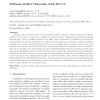Free Online Productivity Tools
i2Speak
i2Symbol
i2OCR
iTex2Img
iWeb2Print
iWeb2Shot
i2Type
iPdf2Split
iPdf2Merge
i2Bopomofo
i2Arabic
i2Style
i2Image
i2PDF
iLatex2Rtf
Sci2ools
JCST
2011
2011
Software Defect Detection with Rocus
Software defect detection aims to automatically identify defective software modules for efficient software test in order to improve the quality of a software system. Although many machine learning methods have been successfully applied to the task, most of them fail to consider two practical yet important issues in software defect detection. First, it is rather difficult to collect a large amount of labeled training data to learn a well-performing model; second, a software system usually contains much fewer defective modules than defect-free modules, in which learning should be conducted over an imbalanced data set. In this paper, we address these two practical issues simultaneously by proposing a novel semisupervised learning approach named Rocus. This method exploits the abundant unlabeled examples to improve the detection accuracy, as well as employs under-sampling to tackle the class-imbalance problem in the learning process. Experimental results on real-world software defect dete...
| Added | 14 May 2011 |
| Updated | 14 May 2011 |
| Type | Journal |
| Year | 2011 |
| Where | JCST |
| Authors | Yuan Jiang, Ming Li, Zhi-Hua Zhou |
Comments (0)

